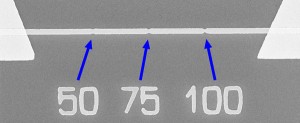Domain-Wall induced Superconducting Spin-valve Effect

Figure 1: An SEM image of the studied superconducting nanostructures; sample layers are (in nm): Si(substrate)/Al(5)/EuS(2)/Cu(10)/Au(5). The Cu/Au capping layers offer protection and ensure continuity for subsequent electrical contacts. The wire width is 300 nm, and the domain wall pinning notches are progressively deeper, with 50-, 75-, and 100-nm depths, respectively.
In a conventional BCS superconductor, conduction electrons with opposite spins are paired up to form Cooper pairs, which is the basis of superconductivity. Because of the preferred antiparallel spin alignment in a superconductor, any attempt to align the spins parallel to each other is destructive to superconductivity. Along this line, in a superconducting spin valve [1] [2], the spin orientation of the neighboring ferromagnets strongly influences the strength of the superconductors and can toggle the superconductivity on and off by aligning two ferromagnets parallel or antiparallel to each other. Here we attempt to use the nature of domain walls to facilitate spin antiparallel configurations. In a bilayer structure based on EuS and Al, strong exchange interaction exists between the Eu2+ ions and the Al conduction electrons, and large spin splitting is directly created onto the Al quasiparticles [3]. Whenever a domain wall nucleates on the fabricated nanowire, Cooper pairs near the domain wall core will sense an antiparallel exchange field and superconductivity is strengthened. As a result, an increase of wire conductance is expected every time a domain wall nucleates. We induce notches of different depth along the wire to systematically control the domain wall pinning strength, which then controls conductivity of the wire. A typical nanostructure made with Al/EuS bilayer thin film to achieve this phenomenon is shown in Figure1. Further electrical characterizations are underway.
References
- G.X. Miao, K. Yoon, T.S. Santos, and J.S. Moodera, “Influence of spin-polarized current on superconductivity and the realization of large magnetoresistance,” Physical Review Letters, vol. 98, pp. 267001, 2007. [↩]
- G.X. Miao, A.V. Ramos, J.S. Moodera, “Infinite magnetoresistance from spin dependent proximity effect in symmetry driven bcc-Fe/V/Fe heteroepitaxial superconducting spin valves,” Physical Review Letters vol. 101, pp. 137001, 2008. [↩]
- J.E. Tkaczyk, and P.M. Tedrow, “Magnetic proximity effect at a superconductor-rare-earth oxide interface,” Journal of Applied Physics, vol. 61, pp. 3368, 1987. [↩]